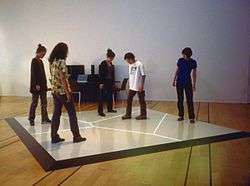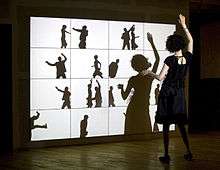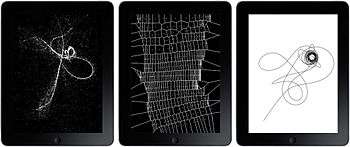Scott Snibbe
| Scott Snibbe | |
|---|---|
 Scott Snibbe at MIT Media Lab (2009) | |
| Born |
August 20, 1969 New York City |
| Nationality | American |
| Education | Brown University, Rhode Island School of Design |
| Known for | New Media |
| Movement | Interactive Art |
Scott Snibbe (born 1969 in New York City) is an interactive media artist, researcher, and entrepreneur. He is one of the first artists to work with projector-based interactivity, where a computer-controlled projection onto a wall or floor changes in response to people moving across its surface, with his well-known full-body interactive work Boundary Functions (1998), premiering at Ars Electronica 1998.[1]
Career
In this floor-projected interactive artwork, people walk across a four-meter by four-meter floor. As they move, Boundary Functions uses a camera, computer and projector to draw lines between all of the people on the floor, forming a Voronoi Diagram. This diagram has particularly strong significance when drawn around people's bodies, surrounding each person with lines that outline his or her personal space - the space closer to that person than to anyone else. Snibbe states that this work "shows that personal space, though we call it our own, is only defined by others and changes without our control".[2]

Snibbe has recently become more broadly known for creating some of the first interactive art apps for iOS devices (iPhone, iPad, and iPod Touch). His first three apps—Gravilux, Bubble Harp, and Antograph—released in May, 2010 as ports of screen-based artwork from the 1990s Dynamic Systems Series, all rose into the top ten in the iTunes Store's Entertainment section, and have been downloaded over 400,000 times.[3] Snibbe collaborated with Björk to produce Biophilia, the first full-length app album, which was released for iPad and iPhone in 2011.[4]

Snibbe received undergraduate and master's degrees in computer science and fine art from Brown University, where he studied with Dr. Andries van Dam and Dr. John Hughes. Snibbe studied animation at the Rhode Island School of Design with Amy Kravitz. After making several hand-drawn animated shorts, he turned to interactive art as his primary artistic medium. His first public interactive work, Motion Phone won an award from Prix Ars Electronica in 1996 and established him as a contributor to the field.[5]

Snibbe's work has been shown at the Whitney Museum of American Art (New York), San Francisco Museum of Modern Art (California), The Kitchen (New York), Eyebeam (New York), the NTT InterCommunication Center (Tokyo, Japan) and the Institute of Contemporary Arts (London, UK). His work is also shown and collected by science museums, including the Exploratorium (San Francisco, CA), the New York Hall of Science (Queens, NY), the Museum of Science and Industry (Chicago, IL), the Cité des Sciences et de l'Industrie (Paris, France), the London Science Museum (UK), and the Phaeno Science Center (Germany). He was also featured on a December 18, 2011 episode of CNN's The Next List.[7]
He has received grants from the Rockefeller Foundation the National Endowment for the Arts, National Video Resources and awards from the Prix Ars Electronica Festival, the de:Trickfilmfestival Stuttgart (Stuttgart Trickfilm-Festival), the Black Mariah Film Festival, and the Student Academy Awards.
Snibbe has taught media art, animation, and computer science at UC Berkeley, California Institute of the Arts, and the San Francisco Art Institute. He worked as a Computer Scientist at Adobe Systems from 1994–1996, on the special effects and animation software Adobe After Effects, named on six patents for work in animation, interface, and motion tracking. He was an employee at Interval Research from 1996-2000 where he worked on Computer Vision, Computer Graphics and Haptics research projects, also receiving several patents in those fields.
Snibbe is the founder of Snibbe Interactive, which distributes and develops immersive interactive experiences for use in museums, entertainment and branding; Scott Snibbe Studio which produces original apps and apps made in collaboration with other musicians and filmmakers; and the nonprofit research organization Sona Research, which researches the socially beneficial applications of interactive technologies. In 2009, Snibbe presented Sona Research's first research paper "Social Immersive Media" at the CHI 2009 conference,[8] coining the term Social Immersive Media to describe interface techniques to create effective immersive interactive experiences focused on social interaction, and winning the best paper of conference award. In November, 2013 Snibbe and Jaz Banga debated Laura Sydell and Christopher M. Kelty in an Oxford style debate entitled, Patent Pending: Does the U.S. Patent System stifle innovation?[9]
Notable works
Interactive Art for the Screen[10]
- Motion Sketch, 1989
- Motion Phone, 1994
- Bubble Harp, 1997
- Gravilux, 1997
- Myrmegraph, 1998
- Emptiness is Form, 2000
iPhone and iPad Apps
- Gravilux, 2010
- Bubble Harp, 2010
- Antograph, 2010
- Tripolar, 2011
- OscilloScoop, 2011
Interactive Projections
- Boundary Functions, 1998
- Shadow, 2002
- Deep Walls, 2002
- Shy, 2003
- Impression, 2003
- Depletion, 2003
- Compliant, 2003
- Concentration, 2003
- Cause and Effect, 2004
- Visceral Cinema: Chien, 2005
- Shadow Bag, 2005
- Central Mosaic, 2005
- Outward Mosaic, 2006
- Make Like a Tree, 2006
- Falling Girl, 2008
Electromechanical Sculpture
- Mirror, 2001
- Circular Breathing, 2002
- Blow Up, 2005
Internet Art
- It's Out, 2001
- Tripolar, 2002
- Fuel, 2002
- Cabspotting, 2005
Public Art Installations
- You Are Here, New York Hall of Science, 2004
- Women Hold up Half the Sky, Mills College, 2007
- Transit, Los Angeles International Airport, 2009
Performance
- In the Grace of the World, Saint Luke's Orchestra, 2008
Film
- Lost Momentum, 1995
- Brothers, 1990
See also
References
- ↑ Stocker & Schöpf, ed.: Cyberarts 98: International Compendium Prix Ars Electronica. Springer-Verlag, 1998.
- ↑ Scott Snibbe: Boundary Functions description at snibbe.com
- ↑ For Digital Artists, Apps Provide New Palette, Reyhan Harmanci, New York Times, August 20, 2010
- ↑ Björk's Biophilia The Guardian, 28 May 2011
- ↑ History of Prix Ars Electronica, 1996 Archived 2010-02-23 at the Wayback Machine.
- ↑ Scott Snibbe: Gravilux description at snibbe.com
- ↑ "Dr. Sanjay Gupta welcomes Scott Snibbe to The Next List - Sunday, Dec. 18". CNN. Retrieved 22 February 2012.
- ↑ Snibbe, S. and Raffle, H. Social Immersive Media: Pursuing Best Practices for Multi-user Interactive Camera/Projector Exhibits. Proceedings of CHI 2009
- ↑ Zero1.org
- ↑ Scott Snibbe website projects page Retrieved May 14, 2011
Sources
- Paul, Christiane (2003). Digital Art (World of Art series). London: Thames & Hudson. ISBN 0-500-20367-9.
- Wilson, Steve Information Arts: Intersections of Art, Science, and Technology ISBN 0-262-23209-X
- Bullivant, Lucy (2006). Responsive Environments: architecture, art and design (V&A Contemporaries). London:Victoria and Albert Museum. ISBN 1-85177-481-5.
- Fiona Whitton, Tom Leeser, Christiane Paul (2005). Visceral Cinema: Chien. Los Angeles: Telic. ASIN: B000BFHTOE.
- ''Better Living through Chemistry'', San Francisco Examiner, November 8, 2001.
- KQED TV documentary on Scott Snibbe, original airdate: April 2005
- Scott Snibbe Studio website
- Snibbe Interactive Website
- Sona Research Website